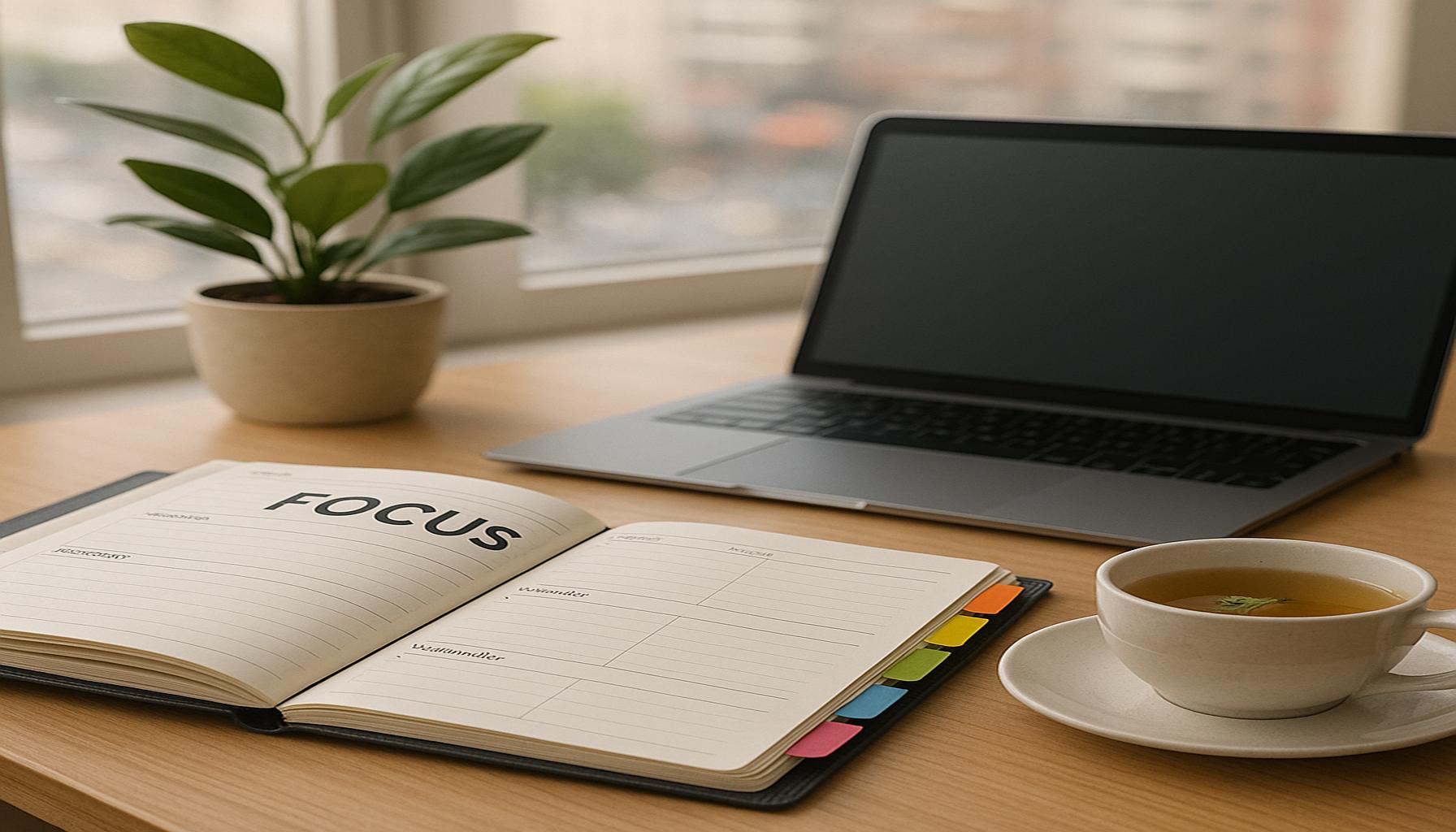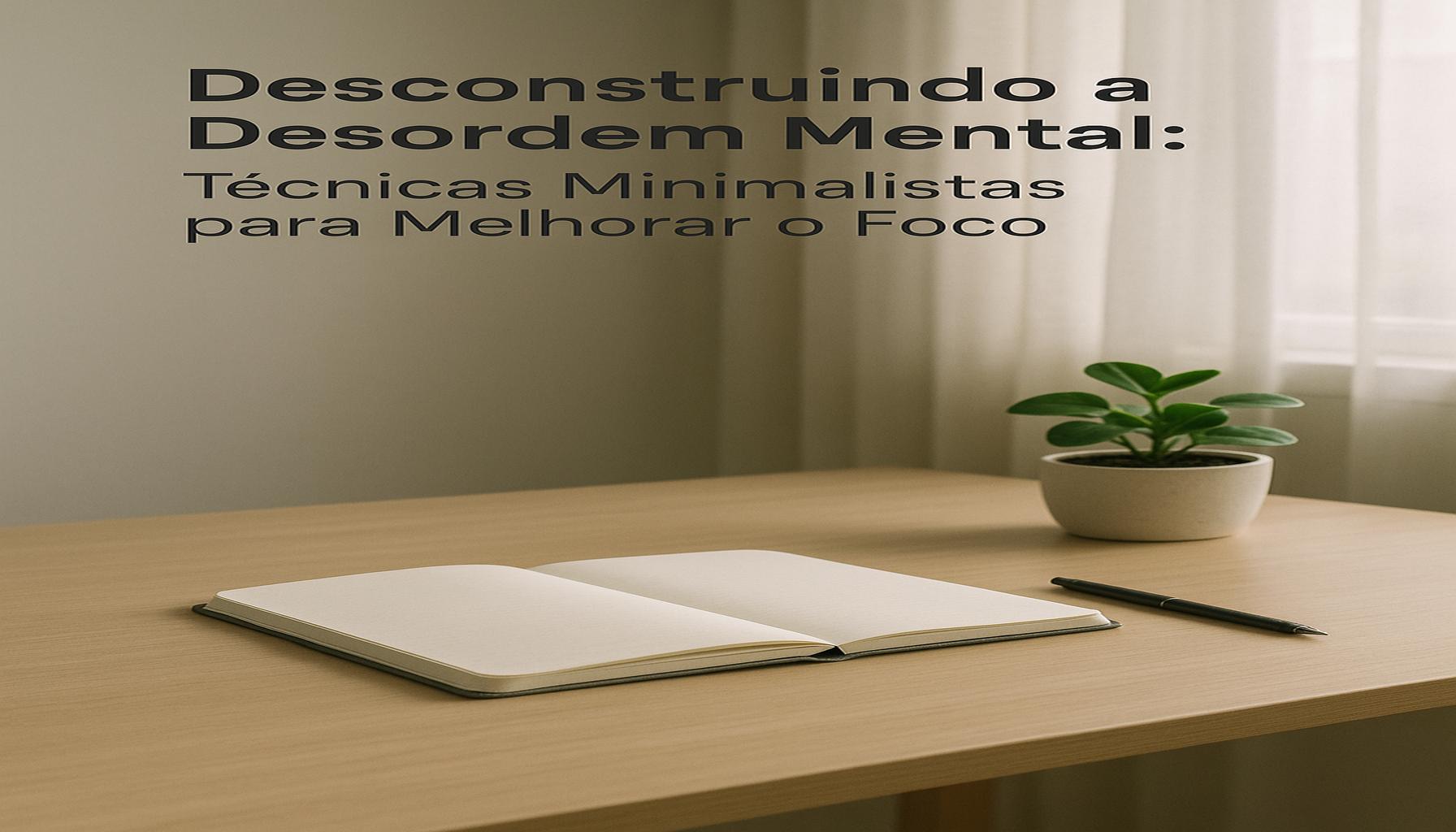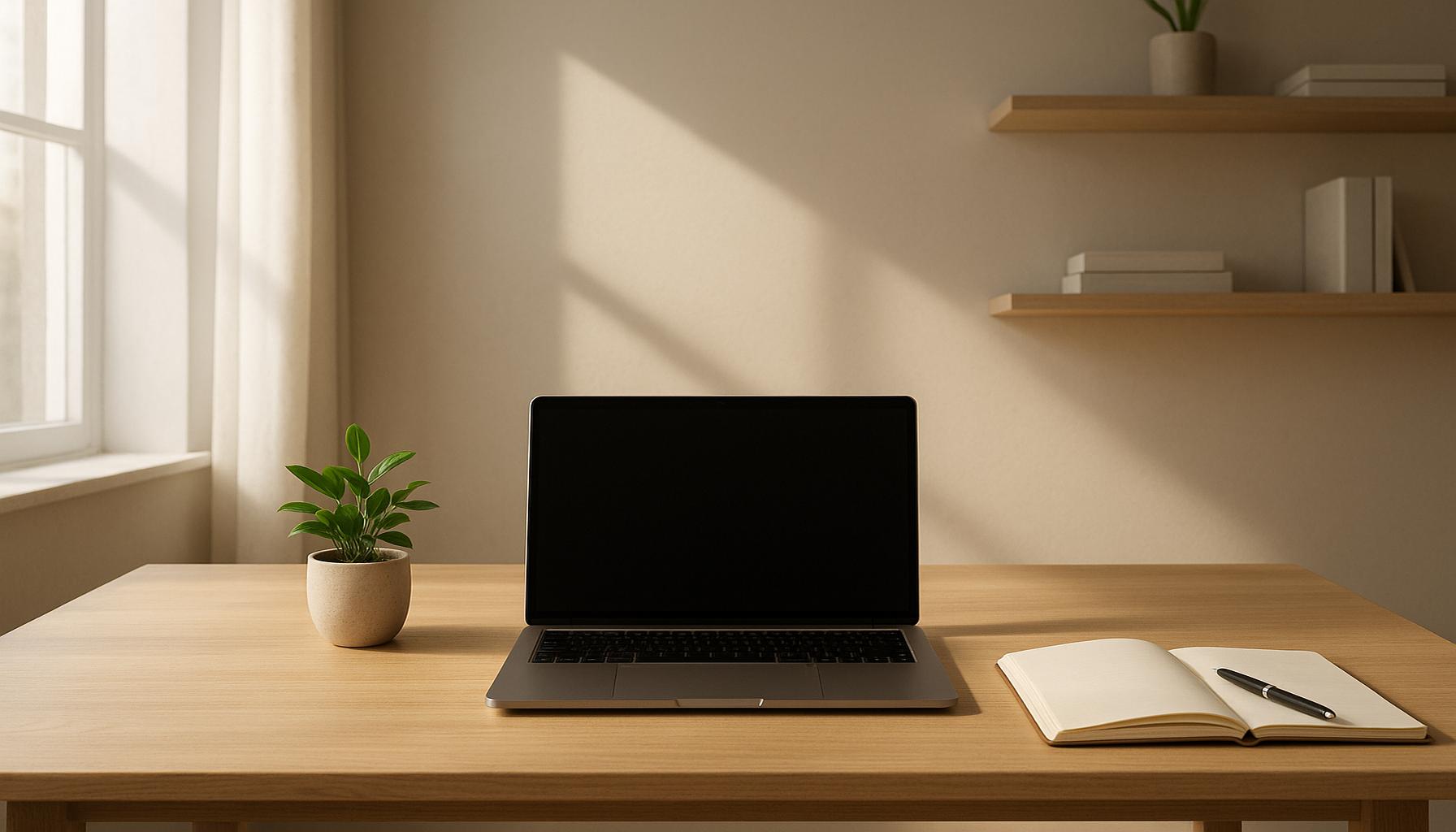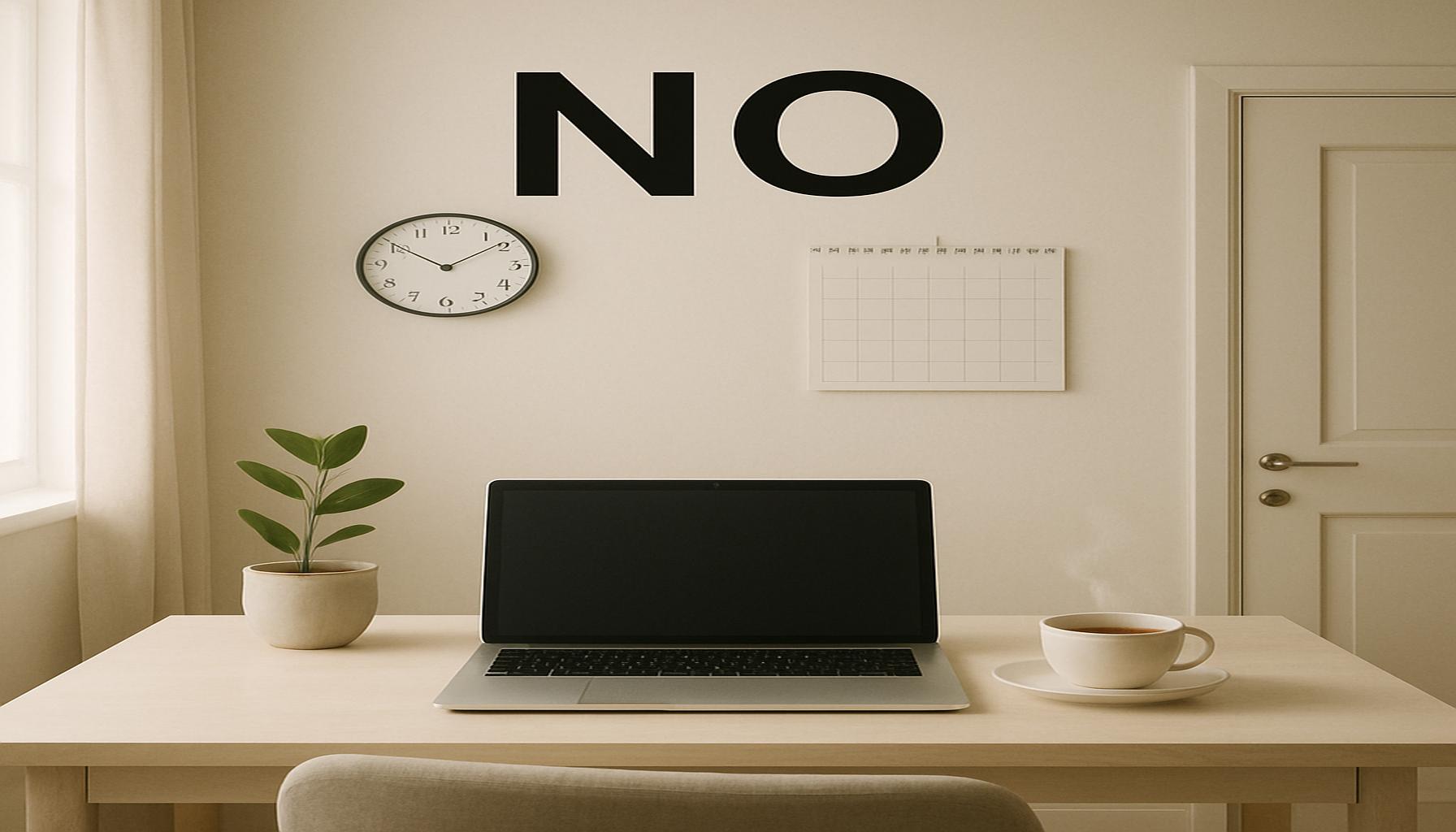Boost Focus Personal Organization Strategies for a Distracting World

Introduction
In today’s fast-paced and constantly connected world, maintaining focus can feel like an uphill battle. With a myriad of distractions at our fingertips, the need for effective personal organization strategies has never been more critical. Minimalism offers a refreshing perspective, emphasizing the importance of decluttering not just our physical spaces, but also our mental landscapes.
Adopting minimalist principles can significantly enhance your ability to concentrate and align with your goals. By simplifying your environment and routine, you can reduce distractions and foster a more productive mindset. This article will explore five essential strategies that can transform your approach to focus and personal organization.
Prepare to discover tools and techniques that can help you navigate through the noise. Each strategy is designed to empower you to create a clear path towards enhanced focus and improved productivity. Let’s dive into the Top 5 Strategies for Cultivating Focus in a world full of distractions.
Top 5 Personal Organization Strategies to Cultivate Focus in a Distracting World
In today’s fast-paced and highly stimulating environment, maintaining focus can feel like an insurmountable challenge. With countless distractions at our fingertips—from social media alerts to the constant barrage of emails—it’s crucial to adopt effective personal organization strategies that promote concentration and productivity. Here is a ranked top 5 list that delves into the best methods to foster your focus amidst distractions.
5. Declutter Your Space
One of the most prevalent sources of distraction can often be our immediate environment. A desk strewn with papers, gadgets, or miscellaneous items can be overwhelming, and this visual chaos often translates into mental disarray. Decluttering your physical space is a foundational method to improve focus. A clean desk or workspace implies a clean mind.

Studies have demonstrated that clutter can cause anxiety, resulting in decreased productivity and an increase in stress levels. In a research study conducted by Princeton University, it was found that clutter can restrict your ability to focus and process information. Thus, having an orderly workspace is crucial for mental clarity.
To start decluttering, try these simple steps:
- Remove unnecessary items: Keep only what you need within arm’s reach. Visual noise can be just as distracting as auditory noise.
- Organize digital spaces: A cluttered desktop can be as distracting as a cluttered desk. Clear your desktop and categorize files into folders. Use tools like digital filing systems to manage your virtual paperwork.
- Evaluate frequently: Schedule a monthly declutter session to maintain order. Regular evaluations prevent chaos from creeping back in, saving time and keeping you organized.
Not only does a decluttered space enhance visual clarity, but it also allows you to prioritize tasks effectively, enabling you to tackle pressing work operations without being mentally distracted by a disorderly environment.
4. Set Clear Boundaries
In a world riddled with notifications and our incessant connectivity, setting clear boundaries is a powerful strategy to enhance focus. The crux of this method is to create distinct separations between work and personal time, effectively managing interruptions. Designating “do not disturb” periods for specific tasks allows your mind to dive deep into work without interruption.
Boundaries might include managing your digital notifications, a source of incessant disruptions. You can increase your focus by proactively disengaging from non-essential communications during critical work periods.
Consider the following approaches to establish your boundaries:
- Limit digital distractions: Use apps like Freedom or Cold Turkey to block social media or other distracting sites during working hours.
- Communicate availability: Inform colleagues of your focused work times and preferred methods of communication during these periods. This assists in setting expectations for response times.
- Designate workspaces: Use dedicated areas for specific tasks, signaling to your mind what’s expected. Associating certain spaces with productivity can condition your brain to be more efficient.
When you establish clear boundaries, you protect your time and create a habit of respecting your own work process, paving the path to heightened productivity and a balanced work environment.
3. Employ the Pomodoro Technique
The Pomodoro Technique is a time management method that breaks work into intervals, traditionally 25 minutes in length, separated by short breaks. This methodology helps maintain focus and helps break down daunting tasks into manageable chunks, making them feel less overwhelming.
The underlying principle is to work with time rather than against it, enhancing your ability to concentrate on singular tasks while avoiding burnout and fatigue. By creating structured intervals, you engage with your workload in a more controlled and focused manner.
Adopting the Pomodoro Technique can be particularly beneficial in several ways:
- Boosts concentration: Knowing you have a break coming up can enhance motivation and allow you to dive deeper into tasks, fully immersing yourself without worrying about burnout.
- Improves time awareness: As you track your work intervals, you become more attuned to how long tasks really take, which aids in planning and prioritizing future tasks more effectively.
- Encourages regular breaks: These breaks reduce burnout and keep your mind fresh throughout the day, providing the mental reprieve necessary to maintain high levels of focus.
By instilling a sense of urgency within these short intervals, the Pomodoro Technique can help you experience a heightened state of focus, making it easier to combat distractions and maintain productivity.
2. Practice Mindfulness Meditation
Mindfulness meditation has gained prominence in recent years and for good reason. It is increasingly embraced as a powerful tool to enhance your ability to concentrate, manage stress, and gain emotional resilience. Mindfulness involves staying present in the moment, in a non-judgmental manner, allowing you to clear mental clutter and focus on the task at hand.
The benefits of mindfulness are backed by science. Harvard researchers found that regular meditation can rebuild the brain’s gray matter in just eight weeks, impacting attention, strengthening discipline, and reducing stress.
Introduce mindfulness into your routine with these impactful strategies:
- Daily practice: Even dedicating a brief 10-15 minutes to mindfulness can recalibrate your focus and is a relatively small investment of time with a significant payoff.
- Focus on your breath: This simple yet profound technique centers your thoughts, drawing your mind back to the present each time it wanders. It’s an immediate tool readily accessible anytime and anywhere.
- Guided meditations: Utilize apps like Calm or Headspace to structure and enhance your practice, offering guided sessions that can range from brief to in-depth.
Implementing mindfulness into your daily routine helps manage thoughts and distractions, ultimately leading not only to greater productivity but also improved overall well-being.
1. Prioritize Tasks with the Eisenhower Matrix
Ranked as the most effective strategy among our top five, the Eisenhower Matrix helps you categorize tasks based on their urgency and importance. Named after President Dwight D. Eisenhower, who was renowned for his productivity, this method enables you to make informed decisions about where to focus your energies, ensuring that critical tasks receive your prioritized attention.
Breaking down tasks into the Eisenhower’s four quadrants simplifies the decision-making process and reduces procrastination, allowing you to address what truly matters.
Here’s how to apply it effectively:
- Quadrant I: Urgent and important tasks should be done immediately. These could be crisis-driven tasks such as deadlines or urgent reports.
- Quadrant II: Important but not urgent tasks should be scheduled for later. This includes planning, strategizing, and personal development activities.
- Quadrant III: Urgent but not important tasks should be delegated if possible. These often involve interruptions like some meetings, calls, or requests for help that others can manage.
- Quadrant IV: Not urgent and not important tasks should be reconsidered. These can include activities that don’t add value to your goals, such as excessive web browsing or trivial diversions.
By adopting the Eisenhower Matrix in your daily routine, you cultivate a priority-driven mindset that aids not only in focus but also in utilizing time more efficiently, thus achieving a heightened sense of control over your work life.
In conclusion, developing and applying these top five personal organization strategies can dramatically elevate your focus and productivity levels. With a structured approach to managing your time, environment, and mental state, you’ll find yourself thriving in a world filled with distractions.
| Category | Key Features | Advantages | Disadvantages | Who Benefits Most |
|---|---|---|---|---|
| Time Blocking | Allocating specific blocks of time for individual tasks or groups of tasks. | Enhances concentration by reducing task-switching; helps to establish a routine. | Time blocks can be too rigid, leading to potential stress if unforeseen tasks arise. | Professionals and students who need to manage disciplines within a busy schedule. |
| Minimalism | Focusing on less, thereby reducing mental clutter and distractions. | Simplifies decision-making and prioritizes only vital tasks; brings clarity in goals. | May require a substantial effort to declutter both physical and digital spaces. | Individuals overwhelmed by choices or physical items vying for attention. |
| Pomodoro Technique | Working in focused bursts of 25 minutes followed by a 5-minute break. | Boosts productivity by making work sessions manageable and preventing burnout. | Frequent breaks can disrupt the flow for some individuals with a different work rhythm. | People struggling with focus or those who easily get distracted during work sessions. |
| Digital Detox | Scheduled break periods from digital devices and social media. | Improves mental health and encourages more physical activities and in-person interactions. | Can lead to missing out on important updates and social interactions in a fast-paced environment. | Individuals feeling overwhelmed by social and digital interactions or those looking to enhance real-life connections. |
The structured strategies outlined highlight the various ecosystems individuals can navigate to sharpen their focus amidst distractions. Time blocking, for example, cultivates an environment conducive to deep work; however, it’s crucial to maintain flexibility to adapt to changing circumstances. Meanwhile, embracing minimalism clears the mental and physical pathways, demanding a concerted effort in initial stages but rewarding a clearer mind for focused endeavors.The Pomodoro Technique operates on the premise that 25 minutes of dedicated labor can lead to formidable achievements, though awareness is key to not letting breaks jolt creativity. A digital detox can be a refreshing reset to prioritize mental health, yet the paradox of being ‘out of the loop’ in the social media age can weigh on some.In short, these personal organization methodologies cater to different lifestyles, and recognizing their distinct benefits and limitations can empower individuals to cultivate greater concentration and productivity.
Frequently Asked Questions about Personal Organization Strategies for Focusing in a Distractive World
How can personal organization really help improve focus?
Personal organization can be a powerful tool in improving focus by helping individuals establish clear priorities and task lists. This allows for a structured approach to tackling daily objectives, thereby reducing the time spent deciding what to do next. With a well-organized plan, you can dedicate uninterrupted time to tasks, enhancing your ability to concentrate. Recent studies indicate that an organized environment can lead to a 15% increase in productivity, as it reduces cognitive overload.
What are some common strategies to organize one’s day to minimize distractions?
Several strategies are recommended for organizing a day to minimize distractions. One popular approach is the time blocking method, which involves allocating specific blocks of time to different tasks. Additionally, using a to-do list or a task management app can help you keep track of important tasks and deadlines. Another effective strategy is setting aside specific periods for checking emails and social media, rather than allowing these interruptions throughout the day. Creating a dedicated, clutter-free workspace can further enhance your ability to focus.
What role does technology play in helping or hindering personal organization?
Technology can significantly aid personal organization by providing numerous tools for task management, scheduling, and reminders. Apps like Trello, Asana, and Evernote are popular for organizing projects and tasks efficiently. However, technology can also be a source of distraction. The key is to use these tools without falling into the trap of constant notifications and alerts. Practicing digital minimalism, where you consciously limit your technology use to what genuinely aids productivity, can help maintain focus.
Are there specific techniques to maintain motivation while cultivating focus?
Maintaining motivation while cultivating focus can be challenging, yet achievable with specific techniques. Setting small, achievable goals can provide regular satisfaction and motivation. Also, implementing a reward system, where completing tasks leads to small rewards, can maintain momentum. It’s vital to periodically review your progress and reflect on your accomplishments, which can reinforce your efforts. Incorporating structured breaks, such as the Pomodoro Technique, can prevent burnout and keep motivation levels high.
How can one build habits that support long-term focus and productivity?
Building habits that promote focus and productivity involves consistency and the gradual introduction of new routines. Begin with identifying your most productive periods of the day and schedule demanding tasks during these times. Practice habit stacking, where you attach a new habit to an existing one, to create seamless daily routines. It’s essential to recognize that building a habit takes time; research suggests it takes an average of 66 days to form a new habit. Patience and perseverance are key.” Use tracking tools to monitor your progress and make adjustments as necessary to support long-term success.
Conclusion: Cultivating Focus in a Distracting World
In today’s fast-paced environment, honing personal organization strategies to maintain focus is more vital than ever. Our exploration of these strategies showcased how intentionality and mindfulness can serve as powerful tools to combat distractions and enhance productivity. The convergence of minimalism and personal organization presents a compelling path towards achieving this aim.
Firstly, embracing a minimalist mindset encourages individuals to declutter not only their physical spaces but also their mental frameworks. By removing unnecessary stimuli, one creates a conducive environment for productivity and focus. This aligns with the essence of minimalism, which emphasizes the importance of having less to accomplish more.
Additionally, techniques such as time-blocking and prioritizing tasks ensure that one’s attention is directed towards meaningful objectives. These practices, though simple in nature, have the potential to transform how we allocate our time and energy. They are essential in a world where distractions are constantly vying for our attention.
Moreover, the integration of technology can be both a challenge and an asset. Harnessing digital tools to streamline organization while setting boundaries against their potential for distraction is crucial. This delicate balance ensures technology remains an ally in our quest for improved focus.
In summary, the synergy between minimalism and personalized organizational strategies provides a robust framework for cultivating focus. By implementing these practices, individuals not only enhance their productivity but also foster a greater sense of clarity and purpose. As you navigate the complexities of a distractive world, consider these strategies as a guide towards achieving a more centered and intentional life.


